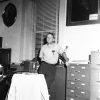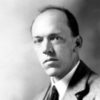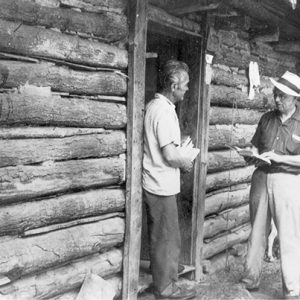calsfoundation@cals.org
Otto Ernest Rayburn (1891–1960)
Otto Ernest Rayburn was a writer, magazine publisher, and collector of Arkansas and Ozark lore. Vance Randolph, in his introduction to Rayburn’s autobiography, Forty Years in the Ozarks (1957), defined Rayburn as a “dedicated regionalist” and added, “There is no denying that, in the period between 1925 and 1950, Rayburn did more to arouse popular interest in Ozark folklore than all of the professors put together.”
Otto Rayburn was born on May 6, 1891, in Hacklebarney settlement, Davis County, Iowa, to the farming family of William Grant Rayburn and Sarah Jane Turpin Rayburn. The family soon moved to Woodson County, Kansas, where Rayburn grew up. In 1909–1910, he attended Marionville College in Marionville, Missouri. In the spring of 1917, Rayburn bought forty acres near Reeds Spring, Missouri. In June, he enlisted in the U.S. Army and served in France. He was discharged at Camp Funston, Kansas, in May 1919. For the next few years, he taught in Kansas and Arkansas schools.
In 1924, he became school superintendent for the Kingston Community Project of the Board of Missions of the Presbyterian Church. He regarded the six years he spent at Kingston (Madison County) as one of the most important epochs of his life. On September 26, 1925, Rayburn married Lutie Beatrice Day of Hopkins County, Texas, and she moved to Kingston. They had two children. He was attracted to Kingston by its isolation, “a community that has a splendid highway in but no road out.”
In Kingston, he published his first magazine, Ozark Life: The Mirror of the Ozarks, beginning in June 1925, edited jointly with James T. (Ted) Richmond. The sixteen-page paper struck the tone that continued in virtually every periodical Rayburn ever undertook from then on, a tone that the late twentieth century called boosterism or hype. Kingston is “Nature’s Beauty Shop,” and the King’s River valley is “one of the fairest dimples in the face of the smiling Ozarks.” He also wrote a column, “Ozark Folkways,” for the Sunday Arkansas Gazette for eight years beginning in 1927, as well as the column “Ozark News Nuggets” in the Sunday Tulsa Tribune.
Rayburn and Richmond sold the magazine in 1931. The same year, in Eminence, Missouri, Rayburn started The Arcadian, sometimes known as The Arcadian Magazine, with the subtitle, “A Journal of the Well-Flavored Earth.” Rayburn wrote much of the material himself, but he also published poetry, fiction, and commentary by other writers. The Arcadian Magazine ceased publication in mid-1932. Rayburn enrolled at East Texas State Teachers College in Commerce, Texas, and published another magazine, Arcadian Life, subtitled, “A Journal of Ozarkian Lore and Pastoral Living,” at Sulphur Springs (Washington County) and Commerce, Texas, from 1933 to 1936. During the summer of 1936, Rayburn received his World War I soldier’s bonus. He returned to Arkansas and discovered Caddo Gap (Montgomery County), a village in the Ouachita Mountains. He taught in the Caddo Gap school and had a writers’ workshop at the Shadow Haven Tourist Courts, owned by Ida Sublette Cobb, a poet and the mother of prominent Republican politician Osro Cobb.
In 1940, Rayburn was commissioned by Duell, Sloan, and Pearce to write the American Folkways Series book on the Ozarks. Ozark Country came out in December 1941. His most successful extended piece, it went through four printings. In 1941, after Ozark Country was finished, he moved to the Rural Dale School in Saline County and in 1943 started another magazine, Ozark Guide. In 1945, he retired from teaching and moved to Eureka Springs (Carroll County), where he opened Rayburn’s Book House. In Eureka Springs, he gave guided tours, sold real estate, and managed the annual folk festival, in addition to publishing Ozark Guide. He published The Eureka Springs Story in 1954 and his autobiography in 1957.
Rayburn died on October 30, 1960, in Fayetteville (Washington County) after a short illness. An Arkansas Gazette editorial called him a “Champion of the Ozarks” and noted that “His Ozark Folk Encyclopedia, a monumental collection… already has served useful purpose and will continue to do so.”
For additional information:
Burnett, Abby. When the Presbyterians Came to Kingston: Kingston Community Church 1917–1951. Kingston, AR: Bradshaw Mountain Publishers, 2000.
Otto Ernest Rayburn Papers. Special Collections. University of Arkansas Libraries, Fayetteville, Arkansas.
Rayburn, Otto Ernest. Forty Years in the Ozarks. Eureka Springs, AR: Ozark Guide Press, 1957.
Shipley, Ellen. “The Literary Enterprises of Otto Ernest Rayburn.” Arkansas Libraries 39 (March 1982): 20–22.
Simpson, Ethel C. “Otto Ernest Rayburn, an Early Promoter of the Ozarks.” Arkansas Historical Quarterly 58 (Summer 1999): 160–179.
Ethel C. Simpson
University of Arkansas, Fayetteville
 Early Twentieth Century, 1901 through 1940
Early Twentieth Century, 1901 through 1940 Folklore and Folklife
Folklore and Folklife Literature and Authors
Literature and Authors Mass Media
Mass Media Ozark Folklore Society
Ozark Folklore Society Ted Richmond and Otto Ernest Rayburn
Ted Richmond and Otto Ernest Rayburn  Otto Ernest Rayburn
Otto Ernest Rayburn 




Comments
No comments on this entry yet.